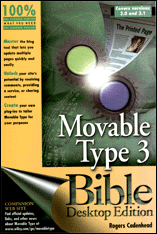Anyone who uses Movable Type on a regular basis needs the book. It covers all of the basics around installation, setting up blogs and writing entries. But then it goes into more advanced topics like alternating the template and adding plugins. And even more advanced topics like RSS, Atom, and writing your own plugins. This is thorough book that is well written and will cover everything you need to know ...
-- Amazon Top 500 Reviewer Jack Herrington
Welcome to the web site for the book Movable Type 3 Bible Desktop Edition by Rogers Cadenhead.
 Developments move so quickly on the World Wide Web that a phrase was coined to describe the sensation: "Internet time." At the height of the dot-com boom, so many innovations were introduced that it was difficult for even the most plugged-in, overzealous Internet geek to keep up with it all (and believe me, I tried).
Developments move so quickly on the World Wide Web that a phrase was coined to describe the sensation: "Internet time." At the height of the dot-com boom, so many innovations were introduced that it was difficult for even the most plugged-in, overzealous Internet geek to keep up with it all (and believe me, I tried).
Today, now that boom has given way to bust, the Internet has become a ubiquitous part of our lives, ingratiating itself into how we work, shop, learn, and communicate. An entire generation is approaching adulthood who have grown up with the Web and e-mail, never knowing what life was like without the opportunity to publish for a worldwide audience at little to no cost.
Although the Web has settled down, there are still some things that hearken back to the time when revolutionary new sites, software, and services launched regularly.
One of those throwbacks is Movable Type, the amazing weblog publishing software from Six Apart.
Links:
- Look Inside the Book on Amazon.Com
- Read the first chapter, Publishing with Movable Type, in PDF Format
- Order the Book from Amazon.Com
- Read Movable Type News and Advice on Workbench
- Contact the Author
Movable Type, originally developed by the childhood sweethearts Ben and Mena Trott as a labor of love, has become one of the rare success stories in the post-boom Silicon Valley. Downloaded more than half a million times and installed on 30,000 servers, Movable Type ranks as the most popular server-based tool for webloggers.
In this book, you'll learn why, adopting Movable Type to publish the personal publishing sites that have come to be known as weblogs.
You'll work with some of the most innovative publishing tools available on the Web, using templates to create pages and other files using the same style of markup as HTML. You will share your work with the RSS and Atom syndication formats, communicate with the software over the XML-RPC Web services standard, and extend the capabilities of the product with your own plug-in scripts.
By the time you finish, you'll be a part of the second Web publishing revolution, using content-management software and databases to create and update your sites in a faster and more creatively satisfying way.
When you have harnessed the capabilities of Movable Type, you can share content on the Web easier than ever before, whether you're interested in authoring a weblog, publishing your digital photographs in a moblog (or mobile blog), or developing something so new that it doesn't even have a name yet.
I wrote the book to encourage Movable Type webloggers to get into the advanced publishing capabilities of the software, such as template design, plug-in programming, and XML syndication with Atom and RSS.
For the book, I spent six months combing over the Movable Type documentation, support forums, source code, and database. I stalked several coders who use the software avidly -- Richard Eriksson, Brad Choate, and Jay Allen could have gotten restraining orders -- to see how people were taking the software beyond the basic publishing capabilities that users master quickly on their own.
Movable Type 3 Bible Desktop Edition is my first book for Wiley, which crams 102,000 words into an edition small enough to carry around. I have never singlehandedly written a longer book that sells for less: at a price of $16.49 on Amazon, you're getting 60 words per penny.